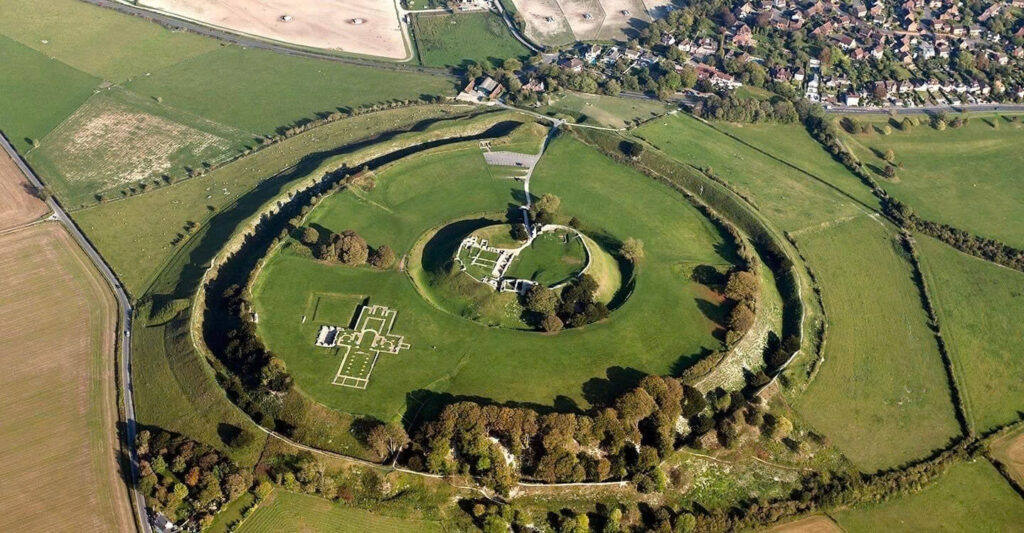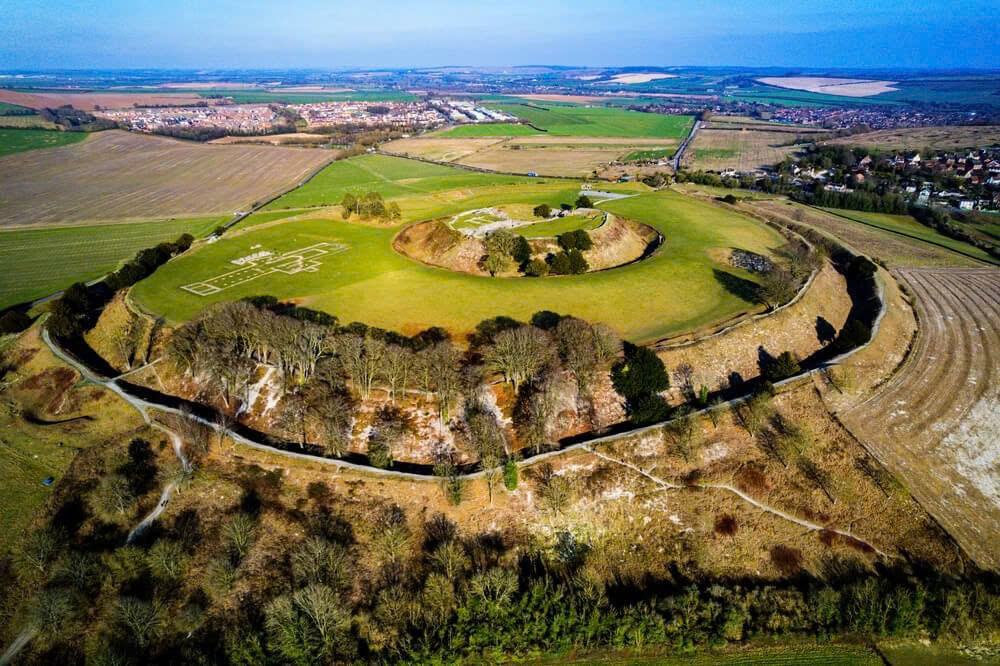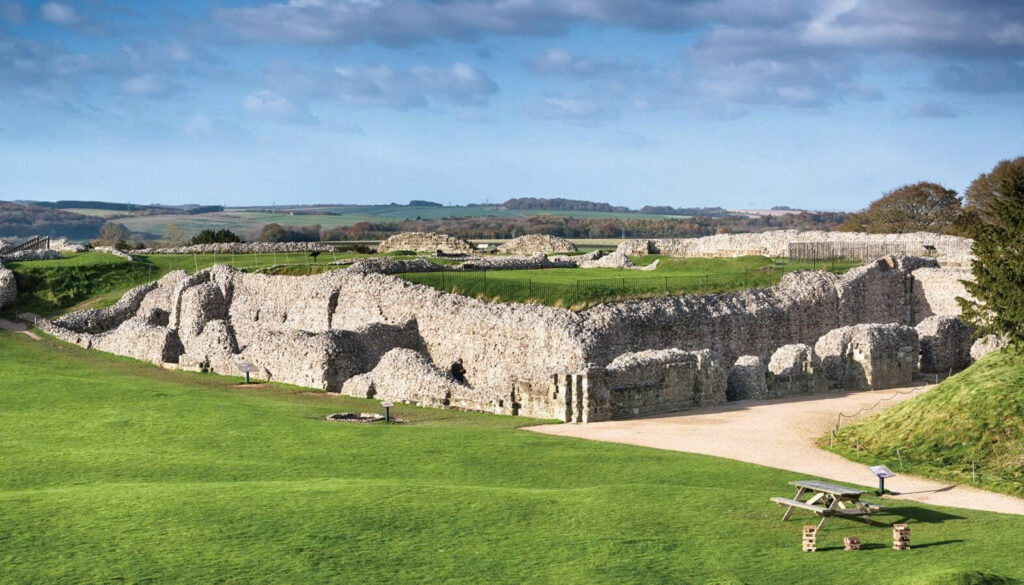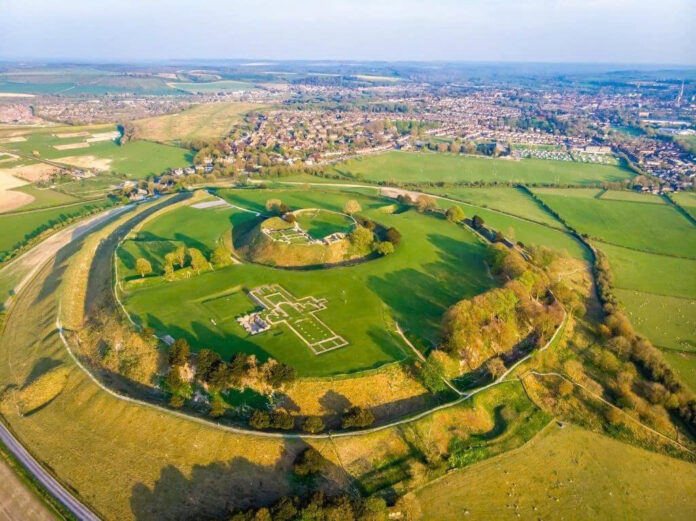Nestled in the rolling hills of Wiltshire, England, Old Sarum stands as a testament to over 1,500 years of British history. This remarkable site, perched dramatically on a chalk hilltop near modern Salisbury, tells the compelling story of how successive civilizations shaped and reshaped one of Britain’s most strategically important locations.
The Ancient Foundations: Iron Age Beginnings
A Strategic Highland Fortress

Around 400 BCE, Iron Age communities recognized the exceptional potential of this elevated position. The sweeping views across the surrounding countryside and proximity to the River Avon made it an ideal location for both defense and prosperity. These early settlers constructed impressive earthen ramparts and deep defensive ditches, creating one of the region’s most formidable hill forts.
Life in the Iron Age Settlement
The inhabitants of this ancient fortress were far from primitive. They established a thriving community that engaged in sophisticated farming practices, extensive trade networks, and skilled craftsmanship. The fertile lands surrounding their hilltop stronghold provided abundant resources, while the strategic location enabled them to control important trade routes for centuries.
Roman Transformation: Imperial Recognition
Military Outpost of the Empire
When Roman legions arrived in the 1st century CE, they immediately understood the site’s military value. Rather than destroying the existing fortifications, they cleverly incorporated the Iron Age defenses into their own military infrastructure. Old Sarum became a crucial link in the Roman network, connecting major settlements like Silchester and Winchester.
Archaeological Evidence of Roman Presence
While the Romans didn’t transform Old Sarum into a major urban center, archaeological discoveries reveal its importance as an administrative and military hub. Roman coins, pottery fragments, and other artifacts uncovered by excavations demonstrate the site’s integration into the broader imperial system, laying the groundwork for its continued significance in post-Roman Britain.
Saxon Revival: Religious and Political Center
The Rise of Christian Influence
As Roman power waned and Saxon kingdoms emerged, Old Sarum found new purpose within the Kingdom of Wessex. The site became increasingly important for both religious and political activities, playing a crucial role in the Christianization of the region. The establishment of a bishopric elevated Old Sarum’s ecclesiastical status, connecting it to the expanding network of Saxon Christianity.
A Focal Point for Medieval Power

During the early medieval period, Old Sarum served as more than just a religious center. It became a nexus of political power, where religious authority and secular governance intersected, foreshadowing the complex relationships that would define medieval England.
Norman Conquest: Castle and Cathedral
William’s Strategic Vision
Following the Norman Conquest of 1066, William the Conqueror immediately recognized Old Sarum’s enduring strategic importance. He ordered the construction of a formidable Norman motte-and-bailey castle, transforming the ancient hill fort into a symbol of Norman authority. This fortress, rising from the heart of the old earthworks, dominated the landscape and projected Norman power across southern England.
The Great Cathedral Within the Walls
The 12th century witnessed Old Sarum’s most ambitious architectural achievement: the construction of a magnificent cathedral dedicated to the Virgin Mary. This grand structure, built within the castle’s outer bailey, established Old Sarum as the seat of the bishop of Salisbury. The unique combination of military fortress and ecclesiastical center created an unprecedented architectural ensemble.
Tensions Between Sword and Cross
However, this proximity between military and religious authorities created inevitable friction. The clergy found themselves constrained by the fortress walls, while the military garrison had to accommodate the needs of the religious community. Despite these challenges, the cathedral represented the growing influence and ambition of the medieval Church.
The Great Migration: From Hill to Plain
Practical Challenges of Hilltop Life

By the early 13th century, the very features that made Old Sarum strategically valuable began to work against it. The exposed hilltop location, steep slopes, and limited water supply made daily life increasingly difficult. The ongoing tensions between religious and military communities further complicated the situation.
Video
Bishop Richard Poore’s Bold Decision
In 1220, Bishop Richard Poore made a momentous decision that would reshape the region’s history. He chose to relocate the cathedral and the entire ecclesiastical community to a new site near the River Avon. This move led to the foundation of New Salisbury, modern-day Salisbury, offering easier access to water, flat land for expansion, and a more hospitable environment for both clergy and laypeople.
Rediscovery and Preservation
Archaeological Renaissance
Though Old Sarum’s political importance declined, its historical significance never faded. From the 19th century onward, antiquarians and archaeologists became fascinated by the site’s layered history. Systematic excavations revealed the remarkable story of continuous occupation and adaptation, uncovering everything from Roman artifacts to Saxon structures and the foundations of the medieval cathedral.
Modern Heritage and Visitor Experience

Today, under the stewardship of English Heritage, Old Sarum continues to captivate visitors from around the world. The site offers a unique opportunity to walk through layers of history, from the ancient Iron Age earthworks to the remnants of the Norman castle and cathedral foundations. The panoramic views of the Wiltshire countryside provide a tangible connection to the landscape that shaped human settlement for millennia.
A Living Monument to British History
Old Sarum represents more than just archaeological remains; it embodies the dynamic nature of British civilization. Each era left its mark while building upon the foundations of the past, creating a palimpsest of human achievement and adaptation. From Iron Age warriors to Roman administrators, from Saxon bishops to Norman lords, each generation recognized and utilized the site’s inherent advantages while adapting it to their own needs and aspirations.
The story of Old Sarum continues to resonate today, reminding us that the places we inhabit carry the weight of history. As visitors stand atop these ancient ramparts, they become part of a continuous narrative that spans from prehistory to the present day, connecting us to the enduring human impulse to build, adapt, and preserve our heritage for future generations.

